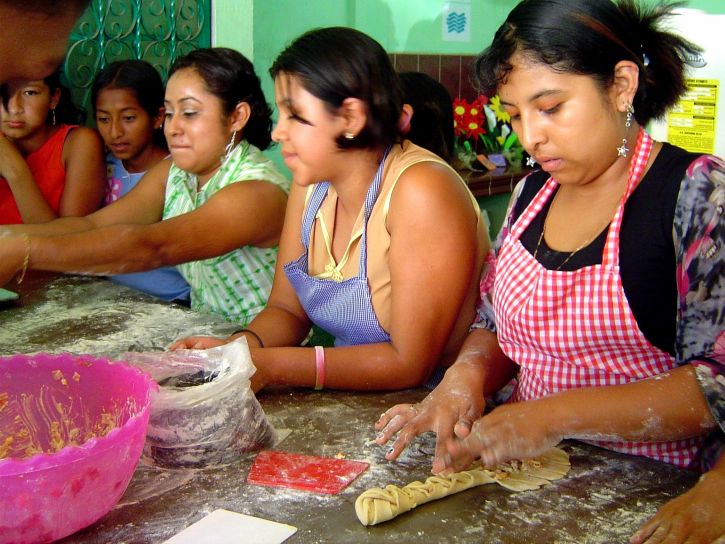Download PDF: Reimer-Barry, Reflecting on Fieldwork
I’ve been at this Tijuana migrant safe house for about five hours, and I start to pack up my things. Jimena stops me.
“Stay for lunch. You have to stay for lunch.”
“I was going to go to the border now so I don’t have to wait as long.”
“But you need to eat, and we are eating now. Stay for lunch.”
I think about it. I am worried about the border line, but I am also worried about whether she will be serving food that my stomach can tolerate. It would be awful to be trapped in my car in a three-hour border wait with a stomachache and diarrhea. She is smiling at me. I do not want to offend this kind woman whose life has been so difficult. How can I complain about a little stomachache and a border wait given the privileges of my life in comparison to hers? I make my decision.
“If you are sure that you have enough.”
“There is always enough. Even when there isn’t.”
She smiles.
We sit together. The meal consists of corn tortillas, salsa, white rice, and a mixture of corn and zucchini cooked together into a mushy ratatouille-like consistency, with sweet rice water to drink.
She serves water from a pitcher, which makes me nervous. I have been told not to drink the tap water. I politely decline and show her that I still have lots of water in my water bottle. They offer the rice water drink as well. I take a sip, and it is super sweet. I think it is made with tap water, too. I do not drink the whole cup.
We are all seated together: four women, two children, Javier, and me. We pass around the food until everyone has a full plate of two soft tacos and filling. Javier gives me a look of warning as I scoop the salsa onto my tortilla, but I fail to understand until I take a bite and—zap!—this is the spiciest salsa I’ve ever tasted in my life. I cough, and my eyes water. I struggle to open my water bottle as tears run down my face, and Javier laughs, explaining to our hosts that I am surprised by the salsa. Everyone laughs together. Without realizing it or intending it, I have broken the ice. We are all laughing together, at my expense, but that is fine with me. After hearing such sad stories all morning, it feels good to share a laugh with these generous women. As I am able to catch my breath and regain my voice, Jimena tells me that she has a question for me.
“Do you believe in God?”
“Oh boy, here we go,” I think. It turns out that I’m not the only person who brings theological questions to the table. For the next hour, the six of us discuss suffering, theodicy, and whether we believe in heaven and hell. And we eat. I left that day with a full stomach and a deep sense of gratitude to these women.1
*****
Just hours earlier I was interviewing Mariana. Mariana is twenty-nine years old. I know from conversations with other residents that Mariana has a reputation for having a bad temper, a bad attitude, and a lazy work ethic. She would sit in front of the television watching soap operas all day if the rest of the women would just leave her alone. Mariana was born in Hermosillo but left home in search of a better life. She was born into a large Catholic family and completed grammar school, but there was a lot of drug use, violence, and dysfunction in her family. She has three daughters, but they are currently living with her mother in Hermosillo. Mariana knew that to find a better life she would have to leave home. She enlisted the help of a family friend to cross the border and ended up in Los Angeles, where she worked at a restaurant until she was fired for showing up drunk. She ended up homeless, was introduced to drugs, and her life spiraled out of control. She was deported after having been arrested in Los Angeles for possession of heroin.
I explain that I’m exploring questions of agency and structural violence, choice and fate. She tells me about the domestic abuse she witnessed as a young child, the poverty of her family and hometown, the victimization that she thought was normal, and how only recently has she begun to understand her inherent dignity. She begins, “There were many times in my life when I was younger that I did not know how to defend myself or how to get help. People would hurt me, and I thought it was normal. I did not have knowledge of my dignity. I did not know what I was worth. Now when I think of my children, and what I hope for them, I hope they do not suffer as their mother has suffered.”2
She stares off into the distance. A cloud seems to come over her face. I think she is going to cut me off, end the interview, shut down and not let me in. But then she starts to cry: “The thing is, I cry because I have not been able to stop using drugs. I am not a good mother. My dream, my dream is to have my house, my own little house, where I can take care of my children. Where I can be a good mother, take my children to school, cook for them, be a normal mother. But I can’t. That’s not the life I chose. It hurts too much.”3
Mariana tells me that she lacks the willpower to stick with the NA recovery program here but that the women in the house keep encouraging her.
As I cook dinner for my family that night, how can I not think about Mariana? How she stares at the television blankly as the soap operas help her to numb the pain, and here I am, doing what she longs to do, just at home cooking a regular normal meal. This is painful for me to think about because there are no easy answers to the questions I ask. Why? Why me? Why not her? And where’s the greater purpose, the meaning, in this comparison of two very different and yet not totally dissimilar juxtaposition of lives? If I were in her shoes, would I also numb the pain as she does? Would my housemates complain about me? Am I a good mother? Is she? Who decides?
*****
On a different visit to this same safe house for migrants in Tijuana,4 my students are scattered around the property. I had encouraged the twenty students in my upper division course to join me on a Saturday immersion experience. I was not there to conduct formal interviews that day, but wanted to make arrangements for future visits. After taking a tour of the facility and hearing some of the residents’ stories, students spread out in smaller groups. Some are playing soccer with the residents, some are visiting with the sick residents in the infirmary wing, and others are hanging out in the cafeteria playing Bingo and Jenga with the residents. I know that we have only an hour or so longer to stay here before our group leaves to have a taco lunch and a conversation about their experiences so far.5
I am distracted because my breasts are leaking. I’m still nursing my infant daughter (although she is not here with me on this Saturday day-trip across the border.) I had brought my breast pump, complete with the battery pack, since I did not know if the electricity would be working today (it often isn’t).
I don’t really speak Spanish. So it is difficult to figure out how to ask Renata, an older woman in the women’s house, if it would be okay to set up my breast pump. It is clear that she does not understand me.
“Leche materna para el bebe?”
But she keeps asking me, “Where is your baby?” I show her the pump. She looks confused.
“Necesito bombear.”
Jimena comes in, and I try to explain. I end up just asking if I can use the bathroom.
“Necesito utilizar de baño? Lactancia?”
They watch me set up the pump. I realize that they are going to stay in the bathroom with me. Well, this is awkward. I feel vulnerable and self-conscious. I’ve never let a stranger watch me pump before. But, ok, here we go. I get all set up and turn it on. When the milk starts spurting out, they point and cheer, and we all laugh together. I have no idea what they are saying, but they seem amazed and surprised. Jimena goes to get two other women, who also come into the bathroom with me and Renata. There we are: me pumping (ench, ench, ench, ench) and these four women watching the milk come out, cheering and laughing and talking.
“¿Cuanto tiempo?” asks Renata.
“Diez minutos,” I say.
“Oh!”
They nod, and Renata ushers everyone out of the bathroom. I’m alone again, with ten minutes to think about what just happened.
*****
In their thoughtful and immensely helpful volume, Ethnography as Christian Theology and Ethics, co-authors Christian Scharen and Aana Marie Vigen explain and defend ethnography for theological ethicists like me. When I was reading it, I often found myself nodding in agreement. Scharen and Vigen write, “When others witness the researcher being a human being, rather than an expert—complete with flaws and humor—they are often more likely to trust the person and share more of what they have come to know.”6 This analysis rings true for me as I think about how my experiences of simply hanging out with the residents of this safe house—sharing meals, attending Narcotics Anonymous meetings, pumping—helped me to build rapport, which helped me to build a sense of trust before the actual recorded interview conversations. Ethnography involves learning from the experiences of other people, which involves getting to know other people. Still, Scharen and Vigen are aware of the difficulties of such a task and offer wise cautions as they encourage theologians to adopt ethnography.
Ethnography has much to offer the church and academy because it has the potential of uncovering new data and giving fresh perspectives to our theological imagination. In the conclusion of the first part of their book, Scharen and Vigen explain, “the ethical questions of our day demand that we leverage the very best information from all possible sources and to appreciate the complex degrees of interpretation happening within each one.”7 Additionally, some scholars point out that ethnography can actually uncover new data or different kinds of data. Patricia Pessar, when describing the value of her ethnographic work on gender and U.S. immigration, says that sometimes ethnography helps us to hear different stories in contrast to other kinds of methodologies. She explains:
In a formal research setting, such as one in which surveys or structured interviews are administered, an immigrant woman’s decision to cloak her own and her family’s experiences in a discourse of unity, female sacrifice, and the woman’s subordination to the patriarch represents a safe, respectful, and respectable “text.” As I look back on my own work, this is the female voice that usually emerged from my attempts at survey research. By contrast, my ethnographic collection of discourses that reveal family tensions and struggles emerged far more frequently out of encounters when my presence was incidental, that is, not the defining purpose for the ensuing dialogue, or after many months of participant observation had substantially reduced the initial formality and suspicion.8
I began my recent work with labor migrants in Tijuana as a university professor with questions about immigration, poverty, agency, and structural violence. When Pessar describes “initial formality and suspicion” in the beginning of a relationship with informants, I understand. I have been there. I’ve been the overdressed academic, fumbling with my notes and recorder, nervous as I introduce myself. I’ve been the suspicious outsider. But I have also been proud of the relationships I have nurtured and pleased when a participant thanks me for listening to his or her story or tells me how much it means to him or her that I keep coming back.
In my research my ideas have been shaped not only by the quantitative data—statistics of migration trends, numbers of border deaths, articles about waves of drug-related violence—but also by the stories, sights, and even smells of fieldwork. I recall the overpowering smell of body odor in a crowded gymnasium full of sweaty men offering support to one another at a Narcotics Anonymous meeting, the savory smells of beans and rice on the stove in the kitchen of the women’s wing of the compound, and the earthy smell of sawdust on the stoop of the woodworking garage mixing simultaneously with the exhaust of decades-old engines getting makeovers in the driveway. I’ve glimpsed another world, so close and yet so far away. It is the world of deported migrants struggling to rebuild their lives away from networks of family and support. It is peopled by the strong and the weary, the timid and the brave. Their world is not mine, but they can tell me their stories and help me to better understand their lives. This is something that I cannot learn by going to the library or conducting an internet search. By some accounts, these two women would be lost in a discourse of statistics: just two women among millions of the deported, all of whom are survivors of some kind of trauma. After getting to know them, I can better understand Jimena’s faith and Marianna’s regret. I can retell their stories to complement the data of structural violence. It helps to put a “human face” on structural violence, which itself is so dehumanizing. On a more personal note, these conversations inspire and challenge me in entirely different ways than more academic readings. I leave with a sense of urgency, with new motivation. I am angry at the injustice of it all!
I have become increasingly sensitive to the power dynamics of my relationships with informants/participants. This remains an important concern for those of us who continue to engage in this work. I suspect that this is in part because we have witnessed bad behavior in the field. We know that well-intentioned colleagues, aid workers, youth groups, or benefactors can and have acted in ways that dehumanize our research partners. Or perhaps we regret our own missteps, knowing how they’ve wounded vulnerable people. I believe that all of us would stop immediately if we perceived that we were doing more harm than good. But how much harm is tolerable? The Institutional Review Board process provides some process by which to demonstrate the seriousness with which we take the protection of human subjects, and yet how many of us have groaned in frustration as we think of the “hoops” through which we must jump in order to have our IRB applications approved in a timely manner?
In thinking about power dynamics in the field and the need for reflexivity, one could probe deeper in reflecting on the first story I recounted about my fieldwork in Tijuana. After all, why was I surprised by Jimena’s question and our resulting hour-long conversation about theodicy and spirituality? What does that say about my own assumptions in the field? To what extent would it be appropriate to call Jimena a theologian? And at the end of the day, whose story am I telling, mine or hers? I often wonder how much of my own perspective and experience I should include in the retelling of my fieldwork stories: my goal is to help the reader enter into the lives of my collaborators and to open up new worlds for my readers, towards the goal of building solidarity across the boundaries that often divide us. I want to be honest about my work as a vehicle and my role as interpreter and narrator without at the same time becoming a distraction and barrier. It is a tough balance to achieve, and I am never confident that I get it right.
A growing number of ethnographers are specifically paying attention to embodiment in the field. Kristy Nabhan-Warren, in her essay “Embodied Research and Writing,” calls for greater inclusion of the body in our approach to research, reflection, and, especially, our written considerations. “The ethnographer’s body can be a barrier, but also a bridge, to cultural exchange and to entering and knowing her interlocutors’ lifeworlds,” she explains.9 Nabhan-Warren challenges ethnographers to take embodied ethnography seriously. And yet, her article does not address the “embodied” experience of race, gender, and resulting power dynamics in the field. Scharen and Vigen do a better job of this reflexive analysis as liberative praxis, as do Whitmore and Browning (among others) in their exemplary chapters.
In thinking about my experiences of embodiment in the field, I think about being white, female, and (comparatively) rich. In this sense, my embodiment was often perceived as a barrier to mutual understanding. I recall my bodily limitations—like having a full bladder as I wait in a long border line. I think about how I was overdressed for interviews in the July heat of Tijuana. I remember shared meals and leaky breasts. But I also think about how my whiteness was visible, and how my embodiment reflects my experiences of privilege. I think about how my research project was put on hold when I was pregnant because I was less comfortable making the trek to the safe house and back when I was pregnant. This underscores the fact that I have choices not available to the residents of the safe house. Reflection on my embodiment in the field helps me understand how I use my own agency within my own situations of constraint—issues that I probed in the stories of my informants as well.
I’m grateful for this book, particularly for its strong defense of ethnography, for its clear descriptions and sensitive attention to issues of embodiment, power, and privilege. As I think about my work, I continue to struggle with questions of representation (problems of speaking with, speaking for), reflexivity (when/to what degree should I write myself in the story, when it is my story or when it is theirs?), interpretation of power dynamics, and about how to both honestly admit power differences while also working alongside informants to transform unjust social structures (i.e., what does “solidarity” mean in these situations of power inequalities?).
Ethnography makes an important contribution in our field because it attends to the experiences of persons whose voices are not always heard and welcomed in mainstream ethics/theology. Listening to others and accompanying them in their struggles for justice constitute important avenues for combating moral blindness in our society today. Face-to-face conversations with people whose lives are very different from our own can help us to see ourselves in a new light, and can help us to understand with a greater degree of clarity and urgency the many issues of injustice that threaten human flourishing. I am excited about the ways that ethnographers are making significant contributions to the field of theological ethics and remain grateful for Scharen and Vigen for explaining and defending this method for a wider audience in the church and academy.10
Notes
- Field notes of the author, July 21, 2011. Tijuana, Mexico.
- Field notes of the author, July 21, 2011. Tijuana, Mexico.
- Field notes of the author, July 21, 2011. Tijuana, Mexico.
- Field notes of the author, March 19, 2011. Tijuana, Mexico.
- I have incorporated service learning in four courses at the University of San Diego: Introduction to Catholic Theology, HIV/AIDS and Christian Ethics, Sexual Ethics, and Catholic Social Thought. The immersion trips to Tijuana (both day trips and a week-long spring break trip) have been especially valuable opportunities for students in the Sexual Ethics and the Catholic Social Thought courses. These service learning partnerships are organized by University Ministry and the Center for Community Service Learning. I am very grateful to the staff members who make this work possible, especially Brenna Hughes, Kim Heinle, Erin Bishop, Maria Gaughan, and Cara McMahon.
- Christian Scharen and Aana Marie Vigen, eds. Ethnography as Christian Theology and Ethics (New York: Continuum, 2011), 26.
- Scharen and Vigen, 74.
- Patricia Pessar, “Engendering Migration Studies,” in Gender and U.S. Immigration: Contemporary Trends, ed. Pierrette Hondagneu-Sotelo (Berkeley: University of California Press, 2003), 28-29.
- Kristy Nabhan-Warren, “Embodied Research and Writing,” Journal of the American Academy of Religion79, no. 2 (June 2011): 380.
- These reflections were originally presented at the Society of Christian Ethics annual meeting in Washington, DC, on January 7, 2011, and have been expanded. I wish to thank the Fieldwork and Ethics Interest Group who organized and hosted the panel discussion. Also, special thanks to all of the panelists and attendees for a vibrant and enriching discussion.






